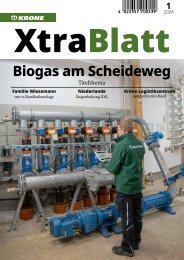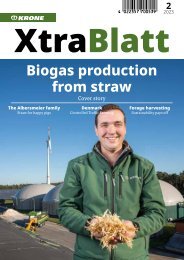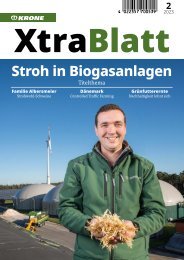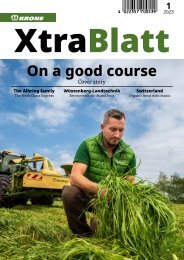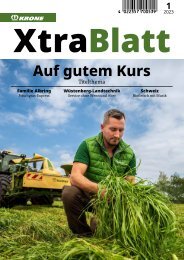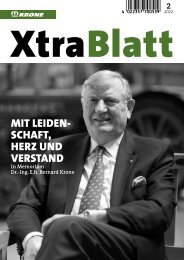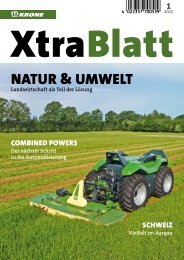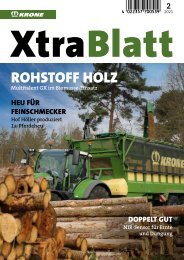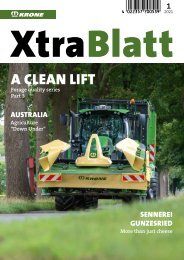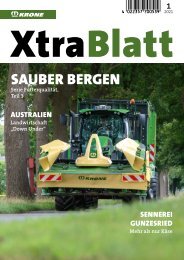XtraBlatt Issue 02-2020
Create successful ePaper yourself
Turn your PDF publications into a flip-book with our unique Google optimized e-Paper software.
TITLE THEME<br />
METZGERSCHLACHTHOF FÜRTH<br />
REGIONAL FROM<br />
CONVICTION<br />
Planning the shortest possible transport distance for meat<br />
is no mere passing fad for this Fürth butchery business. It’s a<br />
deliberate strategy. Here we meet Konrad Ammon jn, master<br />
butcher and managing director of the family business, to discuss<br />
his interesting concept.<br />
Konrad Ammon jn is a self-employed<br />
master butcher and managing director<br />
of the Metzger Schlachthof Betriebs<br />
GmbH in Fürth.<br />
The meat sector stands – as so often – under criticism.<br />
But this time the subject is neither animal welfare<br />
nor hygiene. Instead, it’s the massively increased COV-<br />
ID-19 infection rate amongst workers in a number of large<br />
slaughter companies. Main causes were unsuitable working<br />
conditions and crowded employee accommodation. Both<br />
factors arise directly from the predominating structure of<br />
the industry where workers are mainly subcontracted.<br />
Behind the change in the meat branch that brought today’s<br />
huge company facilities was an originally very commendable<br />
idea: improvement of hygiene in slaughter, jointing and<br />
further processing. However, the EU certification procedure<br />
involved meant hurdles that proved too high for many<br />
smaller businesses. Often, existing buildings made meeting<br />
the regulations impossible and unviable financially. The<br />
result: many butchers gave-up slaughtering, buying their<br />
meat as carcass halves or in other portions from the bigger<br />
slaughter businesses. The municipal slaughterhouses, that<br />
in the past were to be found in nearly every town or city as<br />
part of the fundamental regional facilities, were gradually<br />
closed down for the same reasons.<br />
VACCINE PRODUCTION<br />
This was the fate also faced by the slaughterhouse in Fürth: a<br />
facility, the opening of which way back in 1881, represented<br />
an important milestone in the community’s history, bringing<br />
substantial relief to the citizens of Fürth. Up until then, there<br />
were numerous smaller slaughter facilities that brought with<br />
them problems of noise and odours, not to mention suspect<br />
hygiene. The town butchers were initially sceptical of the<br />
new municipal slaughterhouse. After all, it left them with<br />
just one supply point for their meat. They even boycotted<br />
the opening ceremony and instead, the meat workers’ guild<br />
rather provocatively arranged a day trip to nearby Würzburg.<br />
Gradually, however, butchers came to see the advantages<br />
and the Fürth town slaughterhouse began to flourish. As its<br />
throughput approached full capacity a fusion with nearby<br />
Nürnberg and the building of new facilities were briefly<br />
considered, although nothing transpired. In 1918, before the<br />
end of WW I, the slaughterhouse was extended. In WW II<br />
facilities were partly destroyed with makeshift adjustments<br />
keeping production going. Following the country’s monetary<br />
reform, the town council found it couldn’t finance a new<br />
building. But hope for better production conditions arose<br />
through a partnership with pharmaceutical manufacturer<br />
Behring that was producing a foot-and-mouth vaccine from<br />
deliberately infected cattle in a purpose-built isolation<br />
station, a station which also featured a slaughterhouse. A<br />
cooperation with this slaughterhouse proved very profitable<br />
and incidentally attracted support from state subsidies,<br />
cash that was also invested in the facilities so that by the<br />
1960s Fürth had one of the most modern slaughterhouses<br />
in Germany.<br />
6 7



